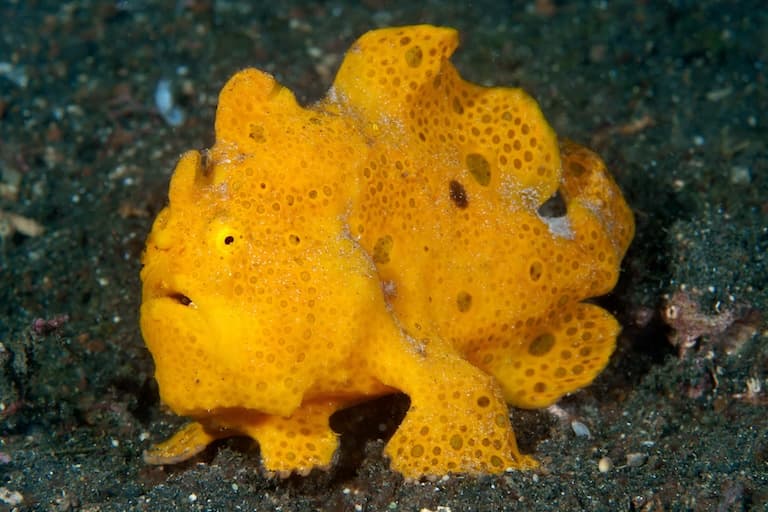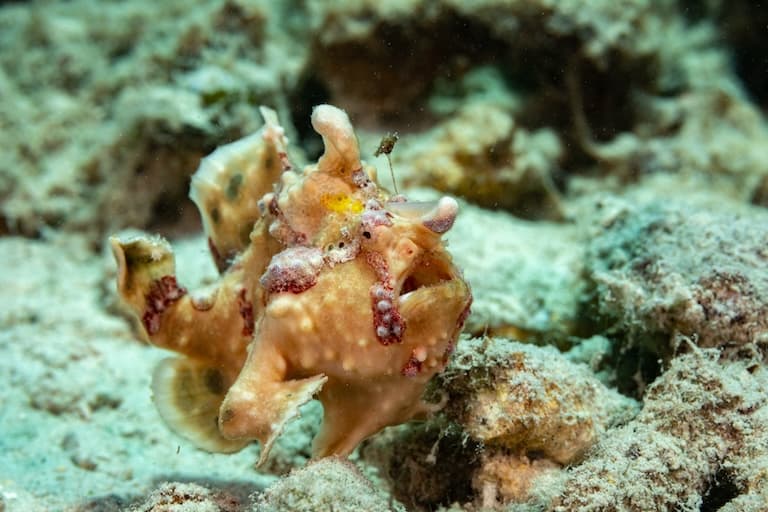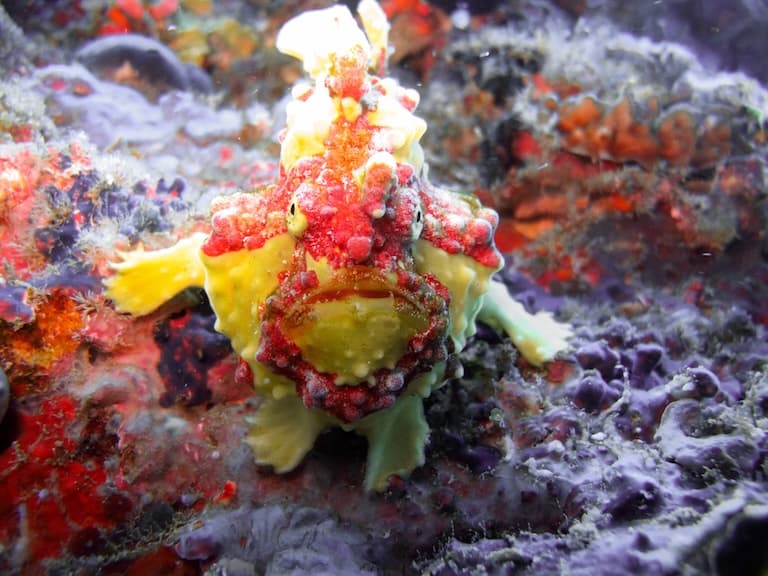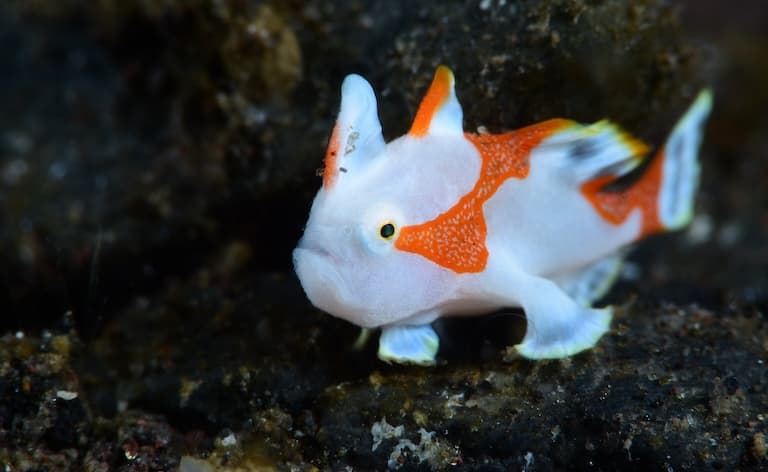Frogfish Profile
The deep ocean is where many of the ugliest bony fishes go to escape the relentless bullying of the sun-kissed shallows. If the photic zone is Miami Beach, the deep is Kensington, PA.
Anglerfishes, perhaps the best-known of all the deep-sea monsters, are predominantly relegated to neglected and forgotten Deepsea subcultures, but a branch of this order didn’t get the memo.
They stay proudly in the shallows, rejecting all notions of pretty privilege and refusing to succumb to body shaming. These are the frogfishes: a family of anglers with a healthy philosophy.

Frogfish Facts Overview
| Habitat: | Tropical, subtropical and temperate coastal marine waters |
| Location: | Worldwide |
| Lifespan: | Unknown |
| Size: | Usually no more than 5-10 cm (2-4 in) long, occasionally up to double this |
| Weight: | Usually no more than 30g (1.1 oz) |
| Colour: | Varied, cryptic, covered in hairs or tendrils, able to change colour |
| Diet: | Small fish, crustaceans |
| Predators: | Larger fish, cephalopods |
| Top Speed: | Slow, but with a fast snap! |
| No. of Species: | Not conclusively grouped; possibly at least 13 genera. |
| Conservation Status: | Most are not listed, Least Concern for those that are |
Frogfish are quite unusual animals: remarkably unappealing in the looks department but quite specialised in a number of ways.
Their ugliness comes from trying to look like amorphous marine algae and other nondescript things, and they pull it off tremendously.
They back up this defence strategy with some unpleasant spines and hunt successfully using a combination of the aforementioned camouflage, a special lure and lightning-fast speed.
In contrast to their shadowy, deep-sea relatives, these shallow-water anglers make use of ambient light to stay camouflaged, even adapting well to otherwise dire situations on the reef.
Interesting Frogfish Facts
1. They’re anglerfishes
Frogfish are an entire family of anglers that have evolved to become shallow-water specialists. Anglers are found all over the world, and at almost every depth, but are best known for floating about in the dark with a bioluminescent lure above their heads.
Frogfish, too, have a lure, though being shallow-water fishes, they don’t need the light. Instead, they have a wiggly appendage that dances around and looks a lot like a morsel of food to the target prey item.
The fact that it’s attached to the enormous mouth of a voracious predator is not enough of a deterrent, apparently. And this is likely because that mouth is heavily camouflaged. 1

2. They’re spiny
Being relatively meaty and nontoxic, frogfish would make a great meal for the majority of larger predators in the shallows, like sharks, for example.
But they have a handful of tricks up their sleeve to prevent this, and one of those tricks is to be covered in thorns.
Thorns are a tried and tested defence dating back hundreds of millions of years in plants, and likely a lot longer than that in animals. In the frogfishes, they may also be venomous, which is a claim that’s often repeated, though the scientific world has little to back it up, yet.
But thorns aren’t the frogfish’s first line of defence – they first rely on their camouflage.
3. They can change colour
Frogfishes are stocky animals, not streamlined at all, and they don’t have to be. Their hunting strategy is to sit and wait, dangling their lure and relying on the shaggy spines and skin pieces that hang off them to disguise themselves as a weedy rock.
To aid in this ruse, they are able to change their skin colour to that of the surrounding area.
This doesn’t happen as quickly as in some other familiar colour-shifters, but they get there in the end, whether it’s a matter of hours or days. In some examples of this, the skill really highlights nature’s ability to make the best of a bad situation.
4. They can hide in bleached coral
Corals, like flamingos, are naturally white. Their colours come from symbiotic algae that live inside them – algae that get expelled from the corals when the water gets too hot.
Coral bleaching is a survivable event in the short term, but its increase in prevalence and length due to climate change is threatening vast swathes of shallow reefs with extinction.
The warty frogfish in the Maldives demonstrates an impressive ability to adapt to what is otherwise a devastating symptom of our changing world by making itself white in response.
But it’s not only white they can take on, these fish are like chameleons of the ocean, adjusting their skin tone to hide in the background.
This no doubt helps hide them from predators but is primarily a hunting strategy, and when a hapless victim comes too close, the frogfish strikes with alarming speed. 2

5. They’re fast
Frogfishes are not keen on moving at all, let alone quickly. They do so only when absolutely necessary, and this allows them to really make it count.
The mouth of the frogfish is about the only part of it that routinely moves fast. When a fish gets close to inspect the predator’s lure, it opens, pulls the fish in and closes again, all within a period of about 0.006 seconds. 3
6. They’re mimics
Frogfishes aren’t just background coloured and covered in hair, some species take their camouflage to a more specific place and can mimic sea urchins or sponges.
In some ways, they have successfully mimicked frogs, being reluctant to move at all but hobbling along in a very amphibian way as they do.
This mimicry was no doubt coincidental since nothing that would otherwise eat them would be wary of a freshwater amphibian, but it was enough for one large ape species to give them the name “Frogfish”.
7. They’re not amphibious
This special walk, and the fact that the fish can survive out of water for a small number of hours, led to the myth that they are capable in both aquatic and terrestrial environments.
But a frogfish out of water can do very little other than wait for the water to come back, so this isn’t any sort of amphibious life to speak of.
Still, it protects them in tidal waters where they may become stranded between low and high tide. 4

Frogfish Fact-File Summary
Scientific Classification
| Kingdom: | Animalia |
| Phylum: | Chordata |
| Class: | Actinopterygii |
| Order: | Lophiiformes |
| Family: | Antennariidae |
Fact Sources & References
- Theodore W. Pietsch (1984), “The Genera of Frogfishes (Family Antennariidae)”, JSTOR.
- Agata Blaszczak Boxe (2016), “Frogfish turns itself white to blend in with bleached corals”, New Scientist.
- Brut America (2022), “Frogfish Have Incredible Hunting Techniques”, YouTube.
- Rachel J. Arnold (2012), “Evolutionary history of frogfishes (Teleostei: Lophiiformes: Antennariidae): A molecular approach”, Science Direct.
